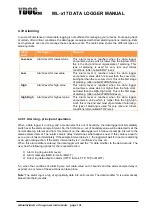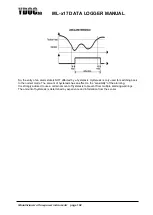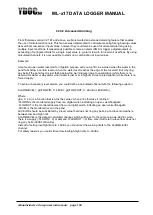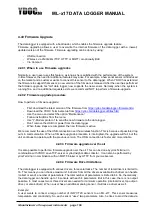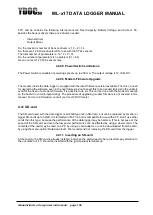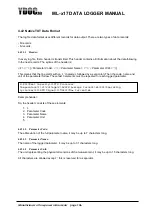
ML-x17 DATA LOGGER MANUAL
Manufacturers of low power instruments
page 95
SDI-12 is a half-duplex protocol, so the data-recorder has to switch between transmitting and receiving. A
convertor from RS232
SDI-12, must perform this task. However, it is not aware of the exact timing of the
protocol. Therefore, it uses fixed (or configurable) delays to switch between TX and RX. After each byte
send by the convertor, it waits, during the fixed delay, for another character, and if it doesn’t arrive, it
switches to RX. The intelligence needed to perform these tasks is mostly done by a microcontroller inside
the convertor, that’s the main reason for its high pricing. This method is doing the job for most cases, but it
is not as good as a real SDI-12 port. The real SDI-12 port is aware of the exact protocol-timings and after
the last character it switches to RX-mode immediately, without the delay. Therefore, no replies are missing.
Your YDOC data logger has a true SDI-12 port.
For more information on the SDI-12 protocol: see
4.33 RS232
The ML-x17DS or ML-x17ADS is provided with and RS-232 port, but it is shared with the SDI-12 and RS-
485 port. You can add an (additional) RS232 port to any ML-x17 by means of an ML-OI-COM-RS232 option
board.
RS232 is a widely spread interface standard, which uses 3 wires (minimum) for data communication. It is
a so called asymmetric interface, that uses one wire for TX, one for RX and one for ground. It is called
asymmetrical, because it uses only one wire per signal. Therefore,
it’s susceptible for interference, and
hence, the maximum cable length is limited to 15meters.
Please keep in mind these limitations when you design your system.
RS232 is not a bus system, and therefore it is only allowed for one device to be connected to a RS232
port. So, the maximum number of serial
devices to connect to your ML-x17 is 1. RS232 sensors should
be connected to the data logger with their signals crossed. That is RX
TX.
We strongly recommend using RS485 instead of RS232, when cable length exceeds the 15m.
4.34 RS485
The ML-x17DS or ML-x17ADS is provided with and RS-485 port, but it is shared with the SDI-12 and RS-
232 port. You can add an (additional) RS485 port to any ML-x17 by means of an ML-OI-COM-RS485 option
board.
RS485 is a serial bus-system, which uses
3 wires for its communication. It uses a “differential balanced
line”, which can span relatively large distances (up to 4000 feet (1200 m)). A rule of thumb is that the speed
in bit/s multiplied by the length in meters should not exceed 10
8
. Thus a 50-meter cable should not signal
faster than 2 Mbit/s.
Instead of RS232, RS485 is capable of communicating with more than one device. After all, it is a bus-
system.
RS485 sensors are called “slaves” and must have their unique address. The data logger acts as a master
and retrieves the information from the slaves. Only one slave can respond to the requests of the master at
a time.
To set up your RS485 sensor for use with the data logger, make sure that the address is programmed
correctly, and that the sensor address is unique.





















